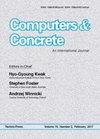太阳辐射下大直径钢管混凝土构件的热场
IF 3.3
4区 工程技术
Q2 COMPUTER SCIENCE, INTERDISCIPLINARY APPLICATIONS
引用次数: 0
摘要
钢管混凝土构件在工程中得到了广泛的应用,其管径也越来越大。但目前还没有对大直径钢管混凝土结构的热场进行研究。这些研究主要集中在太阳辐射下大直径CFST结构的热场。考虑环境因素和实际放置位置,建立了太阳辐射作用下CFST构件热场的有限元模型。通过实际实验验证了有限元方法的正确性。提出了截面上最不利温度梯度模型。试验结果表明,受sr的影响,大直径CFST构件截面温度场呈非线性分布。不同管径CFST构件温度场结果表明,核心混凝土直径越大,中心温度变化越慢,中心与边界存在显著温差。在数值模型的基础上,提出了该断面最不利温度梯度模型。模型表明,圆心周围的温差较小,边界温差较大。最大温差为15.22oC,出现在试件的南部边界区域。因此,在实际工程中,对于大直径CFST构件,有必要考虑SR对构件热场的影响,SR对构件产生较大的温度梯度。本文章由计算机程序翻译,如有差异,请以英文原文为准。
Thermal field of large-diameter concrete filled steel tubular members under solar radiation
Concrete-filled steel tubular (CFST) members have been widely used in engineering, and their tube diameters have become larger and larger. But there is no research on the thermal field of large-diameter CFST structure. These studies focused on the thermal field of the large-diameter CFST structure under solar radiation. The environmental factors and the actual placement position were considered, and the finite element model (FEM) of the thermal field of CFST members under solar radiation (SR) was established. Then the FEM was verified by practical experiments. The most unfavorable temperature gradient model in the cross-section was proposed. The testing results showed that the temperature field of the large-diameter CFST member section was non-linearly distributed due to the influence of SR. The temperature field results of CFST members with different pipe diameters indicated that the larger the core concrete diameter was, the slower the central temperature changed, and there was a significant temperature difference between the center and the boundary. Based on the numerical model, the most unfavorable temperature gradient model in the section was proposed. The model showed that the temperature difference around the center of the circle is small, and the boundary temperature difference is significant. The maximum temperature difference is 15.22oC, which appeared in the southern boundary area of the specimen. Therefore, it is necessary to consider the influence of SR on the thermal field of the member for large-diameter CFST members in actual engineering, which causes a large temperature gradient in the member.
求助全文
通过发布文献求助,成功后即可免费获取论文全文。
去求助
来源期刊

Computers and Concrete
工程技术-材料科学:表征与测试
CiteScore
8.60
自引率
7.30%
发文量
0
审稿时长
13.5 months
期刊介绍:
Computers and Concrete is An International Journal that focuses on the computer applications in be considered suitable for publication in the journal.
The journal covers the topics related to computational mechanics of concrete and modeling of concrete structures including
plasticity
fracture mechanics
creep
thermo-mechanics
dynamic effects
reliability and safety concepts
automated design procedures
stochastic mechanics
performance under extreme conditions.
 求助内容:
求助内容: 应助结果提醒方式:
应助结果提醒方式:


